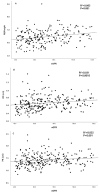Ultrasound Renal Score to Predict the Renal Disease Prognosis in Patients with Diabetic Kidney Disease: An Investigative Study
- PMID: 36766619
- PMCID: PMC9913982
- DOI: 10.3390/diagnostics13030515
Ultrasound Renal Score to Predict the Renal Disease Prognosis in Patients with Diabetic Kidney Disease: An Investigative Study
Abstract
Renal disease associated with type 2 diabetes mellitus (T2DM) has become the leading cause of chronic kidney disease (CKD). Renal ultrasonography is an imaging examination required in the work-up of renal disease. This study aimed to identify the differences in renal ultrasonographic findings between patients with and without DM, and to evaluate the relationship between renal ultrasound findings and renal prognosis in patients with DM. A total of 252 patients who underwent renal ultrasonography at Chungnam National University Hospital were included. Kidney disease progression was defined as a ≥10% decline in the annual estimated glomerular filtration rate (eGFR), which, in this paper, is referred to as ΔeGFR/year, or the initiation of renal replacement therapy after follow-up. The renal scoring system was evaluated by summing up the following items: the value of renal parenchymal echogenicity (0: normal; 1: mildly increased; and 2: increased) and the shape of the cortical margin (0: normal and 1: irregular; right kidney length/height (RH-0 or 1), mean cortical thickness/renal length/height (CKH-0 or 1), and cortical thickness/parenchymal thickness (CK/PK-0 or 1) based on the median: 0-above median, and 1-below median). Patients with DM had thicker renal PKH than those without, despite having lower eGFRs (0.91 ± 0.15, 0.86 ± 0.14, p = 0.006). In the progression group, the renal scores were significantly higher than those from the non-progression group. In the multivariate logistic regression analysis, the higher renal scores, presence of DM, and younger age were independently predicted for renal disease progression after adjusting for confounding variables, such as the presence of hypertension, serum hemoglobin and albumin levels, and UPCR. In conclusion, patients with high renal scores were significantly associated with renal disease progression. Our results suggest that renal ultrasonography at the time of diagnosis provides useful prognostic information in patients with kidney disease.
Keywords: diabetes mellitus; renal replacement therapy; renal ultrasound.
Conflict of interest statement
The authors declare no conflict of interest.
Figures



References
-
- International Diabetes Federation . IDF Diabetes Atlas. 8th ed. International Diabetes Federation; Brussels, Belgium: 2017.
-
- Zerbini G., Bonfanti R., Meschi F., Bognetti E., Paesano P.L., Gianolli L., Querques M., Maestroni A., Calori G., Del Maschio A., et al. Persistent renal hypertrophy and faster decline of glomerular filtration rate precede the development of microalbuminuria in type 1 diabetes. Diabetes. 2006;55:2620–2625. doi: 10.2337/db06-0592. - DOI - PubMed
-
- Plantinga L.C., Crews D.C., Coresh J., Miller E.R., 3rd, Saran R., Yee J., Hedgeman E., Pavkov M., Eberhardt M.S., Williams D.E., et al. Prevalence of chronic kidney disease in US adults with undiagnosed diabetes or prediabetes. Clin. J. Am. Soc. Nephrol. 2010;5:673–682. doi: 10.2215/CJN.07891109. - DOI - PMC - PubMed
LinkOut - more resources
Full Text Sources
Research Materials
Miscellaneous

